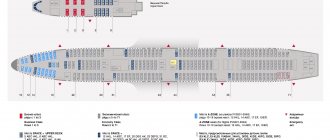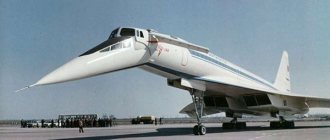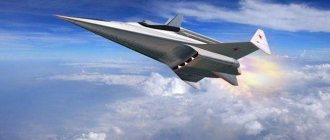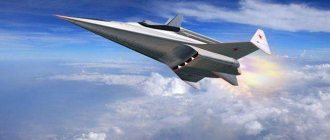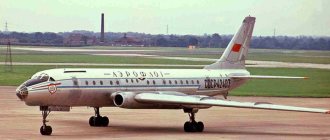On May 28, 2022, a significant event took place for the domestic aviation industry: the newest Russian passenger airliner MS-21 took off from the airfield of the Irkutsk Aviation Plant on its first flight. After the successful completion of the tests, Oleg Demchenko, President of Irkut Corporation PJSC, called this event historic and congratulated the company’s staff. And such a statement does not look like an exaggeration: the excellent flight performance characteristics of the MC-21 passenger aircraft give hope that this airliner will be in demand in the future by both Russian and foreign airlines.
Irkut MS-21 is a program to create a new short- and medium-haul mid-body passenger aircraft, which started at the beginning of the 2000s. Although, in fact, the MC-21 is not one aircraft, but a whole family of passenger airliners, which differ in their passenger capacity, equipment and flight range. The MC-21-300, which will be capable of carrying 211 passengers, is currently undergoing testing. However, another modification of the airliner was developed along with it - MC-21-200 with a maximum passenger capacity of 165 people.
Currently, OKB im. Yakovleva and the Irkut Corporation. Initially, the OKB im. Ilyushin, but in 2008 this company left the project. It was planned that the new vehicle would receive the designation Yak-242, but this idea was later abandoned. Airliners are assembled at the Irkutsk Aviation Plant.
In the future, the main competitor of the MS-21 mainline aircraft will be the Chinese COMAC C919 airliner, as well as the American Boeing-737 MAX and the European Airbus A320 neo.
It should be noted that the cost of the new Russian aircraft is lower than that of its Western competitors. It will range from $72 to $85 million. The price of American and European analogues of the MC-21 aircraft ranges from 90 to 125 million dollars. True, the Chinese SOMA C919 airliners will obviously cost less than the Russian aircraft.
In total, $4.54 billion was spent on the MS-21 project.
So far, MS-21 aircraft are equipped with American PW-1400G engines, but aircraft manufacturers plan to install Perm PD-14 on the aircraft.
History of the creation of the MS-21 aircraft
Work on the creation of MS-21 began back in 2002. In the middle of the last decade, the main project of the Russian aircraft industry was the Sukhoi Superjet 100 passenger aircraft. When it became obvious that the Sukhoi Superjet project would be successfully implemented, the idea arose of creating a larger airliner capable of competing with the products of such global giants as Airbus and Boeing.
According to the creators' plan, the MS-21 should replace outdated Tu-154 aircraft and other aircraft developed during the Soviet period. At the same time, the new airliner will not compete with the Sukhoi Superjet 100, but, on the contrary, will complement it. It is believed that in the future these two aircraft will make up about 80% of our country's passenger aircraft fleet.
Initially, the development of the new aircraft was carried out by the design bureaus of Ilyushin and Yakovlev, and the direct production of the aircraft was entrusted to the Irkut Corporation, which today can safely be called one of the flagships of the domestic aircraft industry. Irkut produces Su-30 combat aircraft, Yak-130 trainers, and also manufactures some components of passenger aircraft for Airbus. In 2008, OKB im. Ilyushin withdrew from the project and specialists from Yakovlev’s design bureau took over its completion. It must be said that many other Russian enterprises participated in the creation of the MS-21, for example, the unique composite wing of the aircraft was developed by the Aerocomposite concern, and the tail unit was created at the Design Bureau named after. Beriev.
It can be added that the MS-21 has a larger number of Russian components compared to the Superjet: 80% versus 60%.
Aircraft manufacturers had grandiose plans; in 2009 it was announced that the new aircraft would take off in 2013, and by 2022 its mass production would begin. However, due to underfunding and difficulties that arose at the design stage, the deadline had to be postponed. In 2010, TsAGI carried out purging of the engines of the future aircraft, and recommendations were given for their further operation.
In 2011, the management of the Irkut Corporation stated that the developers’ priority was to create a modification of the MC-21-300 aircraft with a passenger capacity of 211 seats, since most potential customers are interested in this particular aircraft. They decided to postpone work on the modification of the MS-21-400 (more than 200 seats) until better times, in order to fit into the program budget.
In 2012, Irkut signed a cooperation agreement with Pratt & Whitney, a famous American company engaged in the creation of engines for civil and military aircraft. According to this document, the MC-21 was planned to be equipped with PW1400G engines.
In 2012, a demonstration of an aircraft project with domestic promising PD-14 engines took place. This vehicle was planned to be manufactured for Russian customers, such as the Ministry of Defense, Ministry of Emergency Situations, FSB, etc.
At the beginning of 2014, the Irkutsk Aviation Plant began assembling prototypes of the airliner. In the summer of the same year, tests of a large-scale model of the aircraft were carried out at TsAGI.
It should be said that during the implementation of the MS-21 project in Russia, a new bench base was created practically from scratch, on which individual components and assemblies of the future machine were tested for strength and fatigue, and their aerodynamic qualities were also checked. It can be added that the implementation of this project gave a powerful impetus to the development of enterprises that are part of the UAC. A significant re-equipment of the production facilities involved in the production of the aircraft was carried out. Thanks to the implementation of the MS-21 project, new high-tech companies appeared in the country.
A few months later, Deputy Prime Minister Rogozin announced the date of the first flight of the airliner - April 2022. However, even with this deadline there was a mistake: on June 8, 2022, only the first presentation of the aircraft took place - a solemn ceremony of rolling out the aircraft from the factory hangar; it took another year to prepare the first flight of the aircraft. The first tests of the aircraft went smoothly, the pilots highly appreciated the aerobatic qualities of the new aircraft.
Currently, two MS-21 aircraft have already been manufactured, and eight more are in production.
Previously, the manufacturer's plans to produce 72 MS-21 aircraft per year were announced. The project will begin to make a profit only after the sale of the 350th airliner. Back in 2022, Irkut reported that it already had a firm package of orders for 175 aircraft, some of which had already received prepayments. Most potential clients are domestic aviation and leasing companies. Interest has also been reported from Iranian, Indian and Indonesian companies. In total, the developers plan to sell 1 thousand airliners in twenty years.
Business plan
The MC-21 aircraft, the characteristics of which will correspond to the best analogues and even exceed them, in its size falls into that class of narrow-body long-haul aircraft with one aisle between the rows of seats, which occupies 56% of the world civil aviation market. Competition in this niche is very tough. A project implemented by the Irkut Corporation and its member Design Bureau named after. Yakovlev, with the widespread involvement of domestic companies, is planned to be made highly competitive.
The optimism of the creators is based on the fact that the production of the model will be carried out using completely new technologies and construction materials. The emphasis is also on the design of the MC-21 - the photo of the aircraft attracts attention with its smooth lines, elegance of shape and modern finish.
According to calculations, the sales volume of the MC-21 family of aircraft in all markets will exceed 700 units. Under favorable conditions, the total production volume of aircraft of this type will exceed 1000 units, and the annual production volume may reach 90-100 aircraft. It is expected that the production model will be a third cheaper than its analogues, and fuel efficiency will improve by 15%. And in technical terms, the MS-21 aircraft will be in the lead: its characteristics will be 5-7% superior to foreign competitors of this class.
Description of the design of the MS-21 aircraft
The MS-21 passenger aircraft is designed according to a design that is classic for aircraft of this type and purpose. This is a twin-engine low-wing aircraft with a low-sweep wing and a tricycle landing gear. It should be noted that the MS-21 project involved the development of several modifications of the aircraft, differing in their passenger capacity and fuselage length. Also, initially there were plans to create a passenger airliner with a longer flight range as part of this project.
Composite materials are widely used in the design of the MS-21 airframe. In terms of the volume of their use (about 40%), this Russian aircraft is at the level of the world's best analogues and is second only to the latest American (Boeing 787 Dreamliner - 50%) and European aircraft (Airbus A350 XWB - 53%). The MS-21 wing is made entirely of carbon, which makes it significantly lighter.
The MC-21 has a fuselage of significant diameter, as for aircraft of its class (more than 4 meters), which provides its passengers with a level of comfort comparable to wide-body airliners. It is made mainly of aluminum alloys. The design of the aircraft initially included the possibility of rearranging the cabins, depending on the needs of a particular air carrier.
The MS-21 has a classic three-legged chassis, consisting of two main landing gear and a front landing gear. All three supports have two-wheeled bogies; the heavier modification MS-21-400 may have a chassis with four-wheeled bogies.
The chassis for MS-21 aircraft is manufactured by the Gidromash concern; they are mainly made of steel and titanium alloys.
One of the main “highlights” of the MC-21 airliner is its wing, made entirely of composite materials. Thanks to this, it was possible to significantly reduce its weight, while fully maintaining its strength and performance characteristics. The “black” wing of the MS-21 was developed and is currently being manufactured by the Aerocomposite concern. It is likely that in the coming years this airliner will be the only aircraft of this class in the world with a wing of this design. The tail unit of the aircraft is also made of composite materials.
The MC-21 cockpit has five wide-format displays, which display information about the operation of the aircraft systems and flight parameters. Previously, such displays have not been used in Russian civil aviation.
Until relatively recently, the crew of passenger aircraft consisted of four people: two pilots, a navigator and a flight engineer. Modern airliners are usually flown by two people, with electronics taking over the remaining functions.
On the MC-21, flight control is carried out using sidesticks - special control sticks. At the request of the customer, the aircraft can be equipped with indicators on the cockpit windshield or synthetic vision - a special system that displays the space surrounding the aircraft on electronic displays. This system makes it easier to control the machine in case of loss of visual visibility due to bad weather conditions or time of day. To make the work of pilots easier, special electronic tablets have been developed for them.
Most of the MC-21 onboard electronics were developed and manufactured in Russia in close cooperation with world leaders in this field - Rockwell Collins and Thales.
One of the global trends in aircraft construction is the constant increase in the level of comfort for passengers. The MC-21 absolutely follows this trend: the significant width of the fuselage makes it possible to increase the size of the cabin and the aisles between the seats, which significantly reduces the time of boarding and disembarking passengers. Special passenger seats were developed for the airliner, comfortable for people of different sizes, and special seats were provided for the disabled. The MS-21 cabin will be equipped with the latest multimedia devices for watching movies and playing computer games.
The passenger cabin of the aircraft has large windows that provide sufficient natural light. The intensity of artificial lighting will vary depending on the time of day, which will make it easier for passengers to cope with jet lag. In addition, the designers paid great attention to the microclimate in the cabin: the aircraft is equipped with a special air conditioning and humidification system, it passes through several biological filters, and the temperature is regulated.
In general, the layout of the MS-21 passenger cabin will support two comfort classes: economy and business class. Based on the wishes of customers, the airliner can have one or two classes in the cabin.
The development of life support systems for the MS-21 passenger compartment was carried out by the Russian NPO Nauka in close cooperation with the American company Hamilton Sundstrand. The interior design was created by the French firm C&D Zodiac.
Almost 20% of the MC-21 fuselage volume is occupied by luggage compartments. The aircraft will be able to transport cargo both in special containers and in bulk. At the same time, the luggage compartment of the aircraft has an automatic loader, the use of which significantly reduces the time of unloading or loading luggage.
The MS-21 airliner can be equipped with two types of engines: the American PW1400G, developed by Pratt & Whitney, or the domestic PD-14, which has been developed by Aviadvigatel JSC since 2008. While the PW1400G will be installed on aircraft, these engines are currently considered one of the most advanced in the world; they are used on passenger airliners by Airbus, Mitsubishi, Embraer and Bombardier.
The domestic aircraft engine PD-14 is currently undergoing testing, and it is planned that its mass production will begin next year.
It should be noted that all types of engines that will be equipped with different MS-21 models comply with international environmental norms and standards.
Production technology
The MS-21 mainline aircraft is being developed (Irkutsk). The workshops are equipped with modern equipment. The enterprise has mastered the key technologies and competencies of MS-21 production. The automated final assembly line will use a Durr Systems system. 13 assembly stations have already been put into operation. Serial technologies are used in the production of prototype aircraft. Key competencies:
- Manufacturing of pipelines.
- Making doors.
- Production of fuselage panels and other components.
A set of technical means for crew training has been developed. It includes computer classes and simulators (full flight, procedural, full line of emergency training simulators, as well as a maintenance procedure simulator).
Modifications of the MS-21 aircraft
As mentioned above, the MC-21 is a whole family of passenger aircraft. It includes several modifications that have a very high degree of unification:
- MS-21-200. It is considered the “junior” version of the aircraft. Its passenger capacity is 165 passengers in a single-class configuration. The take-off weight of the vehicle is 72.5 tons, it is planned that it will be equipped with PD-14A or PW1428G engines. Air carriers showed less interest in the MC-21-200 than in the basic modification, so its production will begin later;
- MS-21-300. This is a basic modification of the aircraft. It has a fuselage 8.5 m longer than the MC-21-200. The passenger capacity of this model can reach 211 people in a one-class configuration. The take-off weight of the vehicle is 79.2 tons, it is equipped with PW1431G or PD-14 engines. This modification of the aircraft has aroused the greatest interest among potential buyers, so mass production will begin with it. Prototypes of the airliner are represented by the MS-21-300 modification;
- MS-21-400. An enlarged version of the airliner. It differs from the basic modification in the increased dimensions of the fuselage and wing, and will also probably have a four-wheeled landing gear (according to other sources, it will also have a landing gear with four struts). The passenger capacity of the MS-21-400 will be 230 people, the take-off weight of the aircraft will be 87.2 tons. The airliner is planned to be equipped with a forced PD-14M engine. Due to quite serious changes that needed to be made to the design of the MC-21-400 compared to the base model, the development of this aircraft was postponed.
If the new project is successfully launched, Russian aircraft manufacturers plan to significantly expand the MC-21 family, adding aircraft with a longer flight range and passenger capacity. The near future will show whether they will be implemented.
Prospects for MS-21
The Russian aviation industry has great hopes for the MC-21. Most new domestic aircraft are produced in such small quantities that manufacturers cannot even recoup the development costs for them.
Over the years, the Soviet and then the Russian aviation industry was involved in the development of many projects that remained at the stage of design development or the creation of prototypes. This happened especially often with passenger planes. Moreover, many domestic aircraft that never saw the sky had very good flight performance characteristics, and in some respects they even surpassed foreign competitors. Does the MS-21 have a future, given the highest level of competition that reigns in this area?
The MC-21 is a medium-range airliner, that is, it belongs to the most numerous niche of passenger aircraft. Now such cars occupy 78% of the total number of commercial passenger airliners. To estimate the size of this market segment, we can give only one figure: in the next twenty years, 30 thousand medium-haul aircraft will be sold worldwide. That is, the MS-21 potentially has excellent prospects.
However, competition among aircraft manufacturers is unusually high. Currently, the niche of medium-haul aircraft is almost completely closed by the Boeing 737 and Airbus A320. On May 7, 2022, the Chinese medium-haul passenger airliner Comac C919 made its first flight; its start of operation is planned for 2022. In terms of its characteristics, it is very similar to the MS-21-300, but there is virtually no doubt that the new “Chinese” will cost significantly less not only its Western counterparts, but also the Russian aircraft. The current figure is $50 million. The Chinese manufacturer already states that it currently has a package of 517 firm orders for the C919.
On the other hand, we can state the fact that Russian aircraft manufacturers managed to create a really good aircraft, in no way inferior to its Western counterparts.
This machine will be equipped with the latest Western engine, environmentally friendly and economical, which can be called an undoubted advantage of the project. Because the task of persuading foreign customers to purchase a passenger airliner with a Russian engine is incredibly difficult. Since the collapse of the USSR, the domestic aircraft engine industry has not created a single new engine for passenger airliners and has noticeably lagged behind the world's main manufacturers. Even the engine for the Sukhoi Superjet had to be created in cooperation with the French. The PD-14 will have to be tested first on domestic Russian lines, and only then offered abroad.
Another undoubted advantage is the composite wing of the MS-21. Firstly, it has excellent aerodynamic characteristics, and, secondly, it reduces the weight of the aircraft, which saves fuel.
MS-21 has on-board electronics with a so-called open architecture, which allows the installation of equipment from any manufacturer. The cockpit and passenger compartment are made to the latest international standards.
Since the MC-21 is a new aircraft, its design initially included a large volume of luggage compartment, spacious luggage racks, comfortable and wide seats, as well as significant aisles between them. Existing and promising medium-haul aircraft from Airbus and Boeing are modifications of older models that inherited their fuselages. Therefore, they will not be able to offer such amenities to their passengers.
In addition to the above advantages, MS-21 has a very competitive price compared to Western analogues. However, the fact is that the price of an aircraft indicated in the catalog is only one of the factors that determines the buyer’s choice of a particular aircraft model.
A huge disadvantage of Russian aircraft is the almost complete absence of an after-sales service system. For example, customers receive a warranty (usually 3-4 years) on the main components of the aircraft. In addition, buyers of Airbus and Boeing aircraft know that, if necessary, a new part will be delivered anywhere in the world within 12-14 hours. Also, potential clients are usually offered a whole package of financial options (payment terms, leasing, purchase loans). Over the decades, European and American manufacturers have managed to create a complex system for attracting customers, and neither China nor Russia has anything to oppose this.
However, despite the rather unclear commercial prospects of the Russian airliner, the MC-21 can still be considered a breakthrough for the domestic aircraft industry. It is unknown whether the billions that the state has invested in creating new production facilities and building prototypes will pay off, but in any case, the MC-21 project is a significant step towards Russia’s entry into the international aviation market.
Project advantages
- MS-21 is a new family of medium-haul aircraft for the Russian and global markets.
- A new level of efficiency and comfort in the single-aisle class.
- Advanced technologies in the fields of aerodynamics, materials, propulsion and avionics are created by an international team of leading companies.
- The program is centrally managed, from aircraft development and production to marketing and sales.
- After-sales service is organized.
